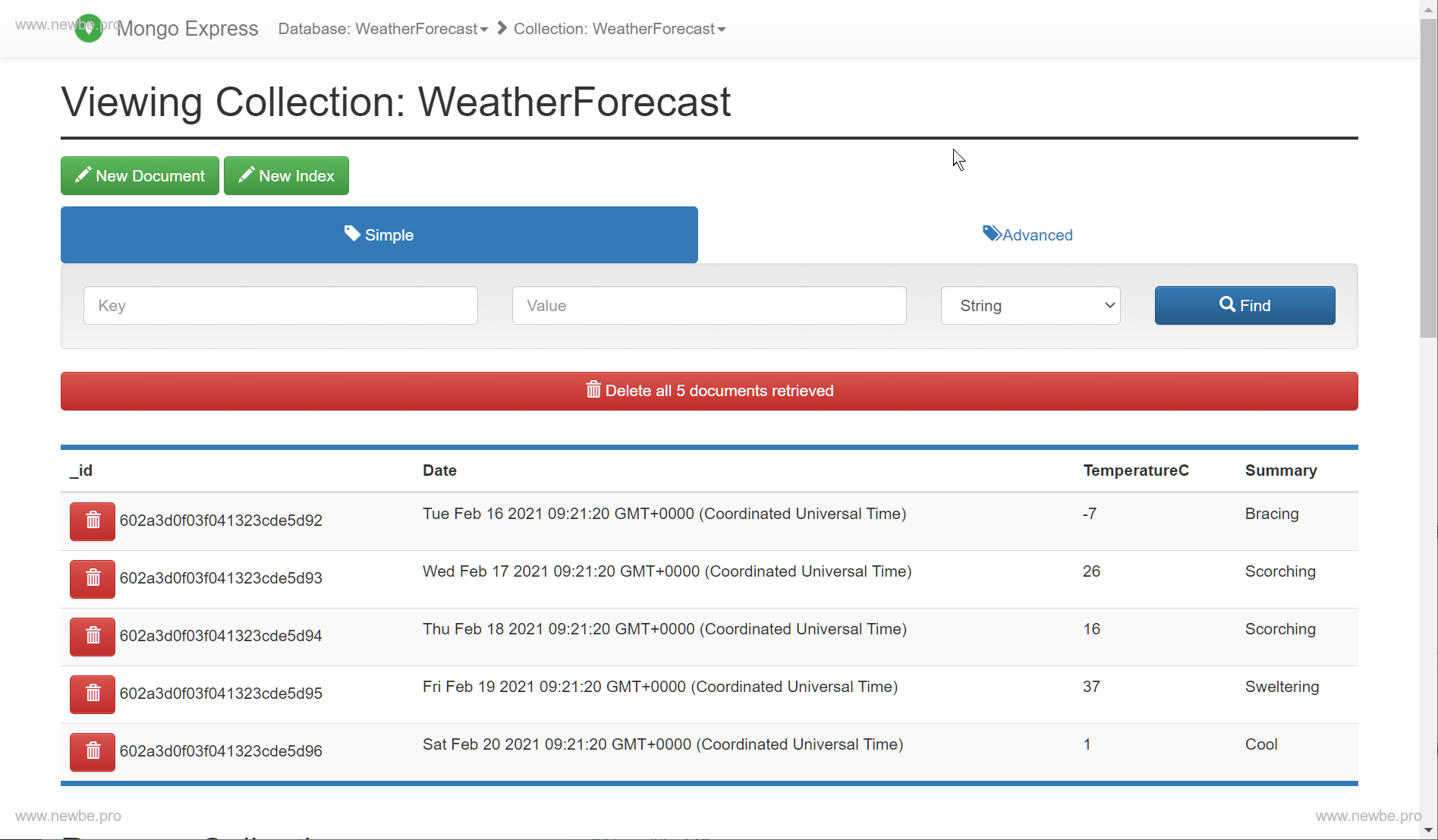Let's explore Tye's more ways of using it.This article we come to find out how to connect to the database in Tye.
Middleware Connection
The vast majority of services need to be used to external middleware to support the proper functioning of the application, usually, in terms of containing databases, cache middleware, message queues, and file systems, and so on.
As a result, a link string to these middleware needs to be managed in the application during the development.
Tye provides a way to manage these linked strings more easily.
Launch of the Mongo with Tye
First of all, we use Tye to start a mongo.
Create a tye.yml manually:
name: mongo-sample
services:
- name: mongo
image: mongo
env:
- name: ME_CONFIG_MONGODB_ADMINUSERNAME
value: root
- name: ME_CONFIG_MONGODB_ADMINPASSWORD
value: example
- name: mongo-express
image: mongo-express
bindings:
- port: 8081
containerPort: 8081
protocol: http
env:
- name: ME_CONFIG_MONGODB_ADMINUSERNAME
value: root
- name: ME_CONFIG_MONGODB_ADMINPASSWORD
value: example
Use tye run to start a mongo locally and at http://localhost:8081 to see data in the mongo via ui:

It is actually using Tye to control the docker desktop to start the mongo.Therefore, you need to install a local docker desktop.
Of course, this doesn't actually make any substantial difference with using the docker-compose.
Create an application to connect to the mongo
Below, we create an app and connect the app with the mongo.
Create a test application and install the necessary package:
dotnet new sln -n TyeTest
dotnet new webapi -n TyeTest
dotnet sln ./TyeTest.sln add ./TyeTest/TyeTest.csproj
dotnet add ./TyeTest/TyeTest.csproj package Microsoft.Tye.Extensions.Configuration --version 0.6.0-alpha.21070.5
dotnet add ./TyeTest/TyeTest.csproj package MongoDB.Driver
Enter Startup to register the MongoClient in the container:
// This method gets called by the runtime. Use this method to add services to the container.
public void ConfigureServices(IServiceCollection services)
{
services.AddControllers();
services.AddSwaggerGen(c => { c.SwaggerDoc("v1", new OpenApiInfo {Title = "TyeTest", Version = "v1"}); });
services.AddScoped(p =>
{
var config = p.GetRequiredService<IConfiguration>();
var connectionString = config.GetConnectionString("mongo");
Console.WriteLine(connectionString);
var client = new MongoClient(connectionString);
return client;
});
}
It is worth thing here that an extended method is used here to read the connection string of the mongo from IConfiguration:
monois actually the service name defined in tyeGetConnectionStringis an extension method fromMicrosoft.Tye.Extensions.ConfigurationThe MongoClientshould be a global single case or aScopeActually the writer hasn't checked the information either.The actual project developer's attention is adjusted to the requirements.
Open the WeatherForecastControllerand let us write some data to mongo each time you accept the request to verify the effect.
using System;
using System.Collections.Generic;
using System.Linq;
using System.Threading.Tasks;
using Microsoft.AspNetCore.Mvc;
using Microsoft.Extensions.Logging;
using MongoDB.Driver;
namespace TyeTest.Controllers
{
[ApiController]
[Route("[controller]")]
public class WeatherForecastController : ControllerBase
{
private static readonly string[] Summaries = new[]
{
"Freezing", "Bracing", "Chilly", "Cool", "Mild", "Warm", "Balmy", "Hot", "Sweltering", "Scorching"
};
private readonly ILogger<WeatherForecastController> _logger;
private readonly MongoClient _mongoClient;
public WeatherForecastController(ILogger<WeatherForecastController> logger,
MongoClient mongoClient)
{
_logger = logger;
_mongoClient = mongoClient;
}
[HttpGet]
public IEnumerable<WeatherForecast> Get()
{
var rng = new Random();
var result = Enumerable.Range(1, 5).Select(index => new WeatherForecast
{
Date = DateTime.Now.AddDays(index),
TemperatureC = rng.Next(-20, 55),
Summary = Summaries[rng.Next(Summaries.Length)]
})
.ToArray();
var mongoCollection = _mongoClient.GetDatabase(nameof(WeatherForecast))
.GetCollection<WeatherForecast>(nameof(WeatherForecast));
mongoCollection.InsertMany(result);
return result;
}
}
}
At this point, the test application was created.The expected effect is that when a request is accepted, some data is written to the WeatherForecast collection in the mongo.It can be viewed through the mongo express UI.
Modify the ty.yml to configure the connection string
Thanks to the front, we have manually created thetye.yml.Therefore, we now make modifications directly on the original basis in order to join the test application.
First, place previously createdtye.ymlat the root ofTyeTest.sln.
Then change it to the following form:
name: mongo-sample
services:
- name: mongo
image: mongo
env:
- name: ME_CONFIG_MONGODB_ADMINUSERNAME
value: root
- name: ME_CONFIG_MONGODB_ADMINPASSWORD
value: example
bindings:
- containerPort: 27017
connectionString: 'mongodb://${host}:${port}'
- name: mongo-express
image: mongo-express
bindings:
- port: 8081
containerPort: 8081
protocol: http
env:
- name: ME_CONFIG_MONGODB_ADMINUSERNAME
value: root
- name: ME_CONFIG_MONGODB_ADMINPASSWORD
value: example
- name: tyetest
project: TyeTest/TyeTest.csproj
Comparing with previse version, there are two changes made:
- Added
tyetestservice configuration to enable test app bindingswere added to themongoservice.This is a way to manage connection for the services intye.TheconnectionStringis the connection string used for other service to connectmongo.
After modification.Start the app withtye run.
Open theswaggerpage, and access the API, then you can see in the mongo express that the data has been successfully completed writing:

After viewing the effect you can useCtrl+Cto stoptyeto remove the relevant containers.
Finally, send it to the K8S to try it out
This is an example that can not usetye deploydirectly.
First, usually, the middleware is not likely to exist in a production environment by way of deployment in a container.Even with a container deployment, it's not going to want to be redeployed every time.That said, it is usually possible to connect the already existing middleware directly.
Second, the intermediate connection string is usually in the form ofsecretink8s.Therefore, it is unlikely to be specified in the tye script.
As a result,tyewill simply help developers check if the requiredsecret already exists in the target cluster that needs to be deployed.When and only if, the requiredsecretexists in the target cluster to deploy.
In this example, you need to havesecretcorresponding tobinding-product-mongo-secretin the target cluster to be deployed usingtye.
The specific name agreed rules can be made with reference to the following contents:
https://github.com/dotnet/tye/blob/master/docs/reference/deployment.md#validate-secrets
Summary
This article, we have successfully completed the use of Tye to complete the link configuration between the application and the middleware.
But there are still some remaining issues:
- What to do if there are multiple bindings in the middleware
- what to do with https binding
For more information, please move to the official documentation to view:
https://github.com/dotnet/tye/blob/master/docs/reference/service_discovery.md
In the next article, we'll go one step further in Tye to implement unified management of complex logs.